An Oratory entirely dedicated to the Immaculate Virgin Mary
The History
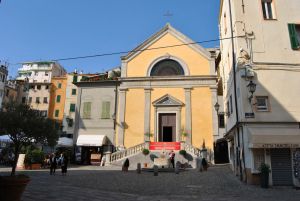 The building is oriented with the façade to the west and is located in front of the main entrance of the Basilica Co-cathedral of San Siro. The construction of this church, commissioned by the abbot Jacopo Palmari, is probably related to the development of the confraternities in western Liguria starting from the 15th century. Some historians claim that the primitive building was erected on the perimeter of an ancient Roman octagonal fanum.
The building is oriented with the façade to the west and is located in front of the main entrance of the Basilica Co-cathedral of San Siro. The construction of this church, commissioned by the abbot Jacopo Palmari, is probably related to the development of the confraternities in western Liguria starting from the 15th century. Some historians claim that the primitive building was erected on the perimeter of an ancient Roman octagonal fanum.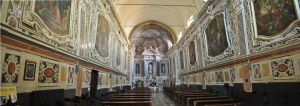 The oratory, with a single rectangular hall, is long and narrow as it was intended to house the confraternities in wooden benches arranged along the walls and now disappeared. These wooden benches reached the height of the small flat brand cornice, which is why the marble decoration starts from that level. In 1563 Gio Francesco Grosso founded a chaplaincy with the obligation of the festive mass which was a way to provide the church with funds.
The oratory, with a single rectangular hall, is long and narrow as it was intended to house the confraternities in wooden benches arranged along the walls and now disappeared. These wooden benches reached the height of the small flat brand cornice, which is why the marble decoration starts from that level. In 1563 Gio Francesco Grosso founded a chaplaincy with the obligation of the festive mass which was a way to provide the church with funds.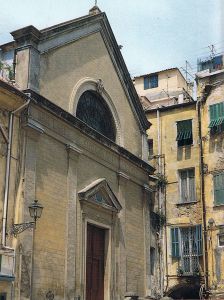 On the 14th June 1608 the canons of San Siro granted a portion of the cemetery adjacent to the original place of worship to the Archconfraternity of the Immaculate Conception in order to build the new oratory. The work went on for several decades, so much so that in 1636 a first stone was laid for the reconstruction of a part that had been destroyed, while still in 1656 a wooded area belonging to the Archconfraternity was ceded in order to further speed up the work for the construction of the oratory. The construction continued until at least 1678, when the choir was completed. The realization of the works owed much to the constant and active interest of the abbot Gio Battista Palmaro. It can be said with certainty that the Palmari family had a sort of historical and family bond on the building, which led them to consider it as a family church.
On the 14th June 1608 the canons of San Siro granted a portion of the cemetery adjacent to the original place of worship to the Archconfraternity of the Immaculate Conception in order to build the new oratory. The work went on for several decades, so much so that in 1636 a first stone was laid for the reconstruction of a part that had been destroyed, while still in 1656 a wooded area belonging to the Archconfraternity was ceded in order to further speed up the work for the construction of the oratory. The construction continued until at least 1678, when the choir was completed. The realization of the works owed much to the constant and active interest of the abbot Gio Battista Palmaro. It can be said with certainty that the Palmari family had a sort of historical and family bond on the building, which led them to consider it as a family church.
Between the end of the XV and the XVIII century the Oratory underwent many interventions that gave it to our generations as we can see it today. Below is a short list of works:
- Immediately after the construction of the Oratory its decorative apparatus was carried out with the succession of marble inlays of an exquisitely baroque nature, characterised by significant chromatic combinations of the materials of the presbytery;
- In 1720, another sector of the wall was assigned to Gaetano Solaro, a Lombard-Ticino artist, who, however, carried out a work considered unsatisfactory, so much so that the final assembly of the marble sectors was completed by Gio Andrea Manni and Gio Andrea Mazzetti, two Ticinese who were also working in Sanremo at the time;
- In 1758 a member of the Sivori family from Genoa intervened to decorate the area located near the pulpit;
- In 1770 the land for the new sacristy was purchased and two years later the access to the oratory was modified with the construction of two parallel flights of stairs on the façade, while previously the stairs descended in a fan shape towards the square, which remained partly occupied;
- During the 19th century, for various reasons, the building could not be kept in good condition and many events contributed to its degradation, including, in 1871, the occupation by a military garrison.
After 1928, the facade was partially demolished, but the first project had already been prepared in 1850.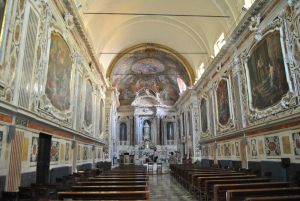 While the exterior is very sober and almost poor, the interior is extraordinarily rich in Baroque marble inlay decorations, made by various Lombard-Genovese marble workers between the 17th and 18th centuries, with the most massive interventions carried out around 1667.
While the exterior is very sober and almost poor, the interior is extraordinarily rich in Baroque marble inlay decorations, made by various Lombard-Genovese marble workers between the 17th and 18th centuries, with the most massive interventions carried out around 1667.
The vault of the presbytery
The area of the presbytery presents a remarkable chromatic intensity decorated with rich marble from before 1683. The decoration of the vault frescoed by the Genoese painter Giovanni Battista Merano (1632-1698) was executed in 1695. The artist represented the Eternal Father in glory with angels and prophets.
The nave
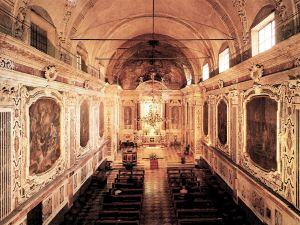 The area of the sacred hall is marked by a very simple lunetted sail configuration, resting on a cornice that develops along the inner contour of the sacred building.
The area of the sacred hall is marked by a very simple lunetted sail configuration, resting on a cornice that develops along the inner contour of the sacred building.
I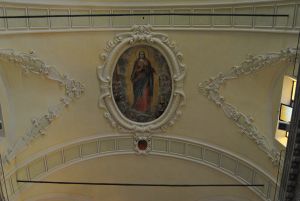 n the centre of the vault in a valuable stucco relief frame the Immaculate Madonna is depicted in a fresco dated 1630. To be noticed at the feet of the Virgin a man dressed according to the fashion of the XVII century, kneeling in adoration: it is the abbot Gio Battista Palmaro who did so much in that historical period to make the Oratory beautiful.
n the centre of the vault in a valuable stucco relief frame the Immaculate Madonna is depicted in a fresco dated 1630. To be noticed at the feet of the Virgin a man dressed according to the fashion of the XVII century, kneeling in adoration: it is the abbot Gio Battista Palmaro who did so much in that historical period to make the Oratory beautiful.
The statue of the Immaculate
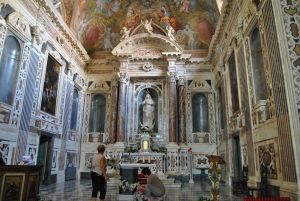
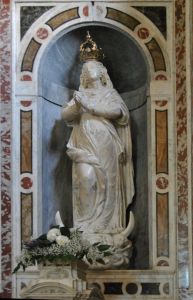 The valuable marble statue of the Immaculate Madonna dominates the entire sacred hall and is a sculptural work by the marble artist Scivoli di Genova. The Virgin is depicted leaning on a vortex of clouds, heads of angels and the moon, with her hands joined, with her sweet face turned upwards in the act of crushing the snake. The dress worn shows a rich drapery that gives life and movement to the image and shows a remarkable artistic ability of the sculptor. It was completed in 1775, together with the harmonious tabernacle and altar.
The valuable marble statue of the Immaculate Madonna dominates the entire sacred hall and is a sculptural work by the marble artist Scivoli di Genova. The Virgin is depicted leaning on a vortex of clouds, heads of angels and the moon, with her hands joined, with her sweet face turned upwards in the act of crushing the snake. The dress worn shows a rich drapery that gives life and movement to the image and shows a remarkable artistic ability of the sculptor. It was completed in 1775, together with the harmonious tabernacle and altar.
The pictorial cycle
The interior of the oratory is characterised by the presence of a significant collection of remarkable works of art from the Ligurian seventeenth-eighteenth century. The marble walls are embellished with oil paintings depicting various episodes from the Stories of the Life of the Virgin.
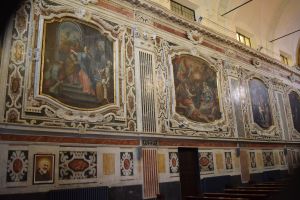
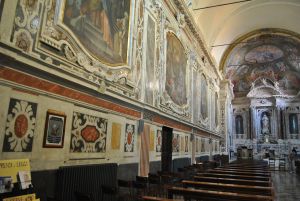 From the presbytery we find on the left the Nativity of Mary by the famous Sanremo painter Tereso Maria Languasco (Sanremo 1654-Genoa 1698), born Tommaso Ludovico Languasco, who changed his name when he entered the order of the Discalced Augustinians. The author is appreciated for the illustrative capacity inferred by his master Giovanni Battista Carlone as well as for the classical vein of Emilian style, always very appreciated in Sanremo between the 17th and 18th centuries.
From the presbytery we find on the left the Nativity of Mary by the famous Sanremo painter Tereso Maria Languasco (Sanremo 1654-Genoa 1698), born Tommaso Ludovico Languasco, who changed his name when he entered the order of the Discalced Augustinians. The author is appreciated for the illustrative capacity inferred by his master Giovanni Battista Carlone as well as for the classical vein of Emilian style, always very appreciated in Sanremo between the 17th and 18th centuries.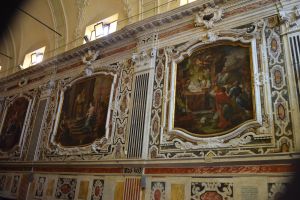
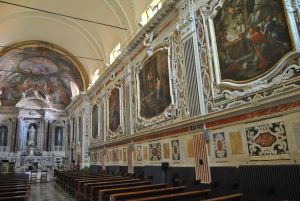 This is followed by the Presentation of Mary at the Temple by an unknown Ligurian painter, dated around 1723, as is the painting opposite in correspondence.
This is followed by the Presentation of Mary at the Temple by an unknown Ligurian painter, dated around 1723, as is the painting opposite in correspondence.
Then there is the remarkable Sposalizio della Vergine (Marriage of the Virgin) by Jacopo Antonio Boni (1688-1766) from Bologna, a work he painted in 1727, when he was engaged in the frescoes of the Sanctuary of the Madonna della Costa.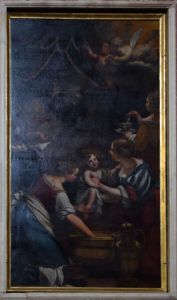 Below is the Annunciation, an elegant solution by a local painter still influenced by models referring to Correggio, executed in 1758 for the relationship with the clients
Below is the Annunciation, an elegant solution by a local painter still influenced by models referring to Correggio, executed in 1758 for the relationship with the clients 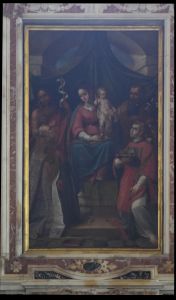 indicated, namely Domenico and Sebastiano Calcagno.
indicated, namely Domenico and Sebastiano Calcagno.
The Visitation and the Nativity of Jesus, which face each other at the beginning of the left and right walls respectively, are the work of the little known Sanremo painter Girolamo Bosio and can be dated to 1772. The Visitation is an evident copy of the original by Francesco Barocci in the Chiesa Nuova of Rome, which in turn can be dated between 1583 and 1588. The Bosio in this case adapts to a rather rigid model, although he has a more lively late baroque vein, as shown in the only other known work, an Ascension for the church of San Giuseppe in Sanremo. Also the Presentation of Jesus at the Temple is close to the Boni manner or, better, a more generic Bolognese one, appreciable for its classicistic solutions.
The following Pentecost is an early eighteenth century realization linked to models of the previous century of popular and certainly local production. The Death of the Virgin is still linked to Bolognese models close to Jacopo Antonio Boni, given a possible date around 1720-1723.
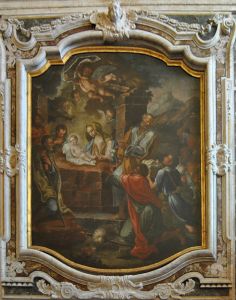 Finally, in the presbytery there is a canvas with the Madonna and Child Jesus and Saints John the Baptist, Gregory the Great, Stephen and Joseph. This work is not related to the others as far as the subject is concerned, but can be dated between the 16th and 17th centuries, close to the manner of Bernardo Castello (1557-1629).
Finally, in the presbytery there is a canvas with the Madonna and Child Jesus and Saints John the Baptist, Gregory the Great, Stephen and Joseph. This work is not related to the others as far as the subject is concerned, but can be dated between the 16th and 17th centuries, close to the manner of Bernardo Castello (1557-1629).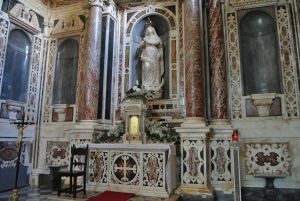 At the altar there is also an interesting processional Crucifix dating back to the 15th century.
At the altar there is also an interesting processional Crucifix dating back to the 15th century.
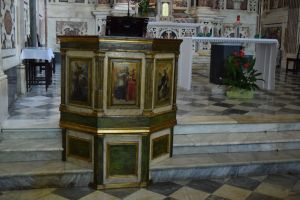 The ambo is obtained from the ancient and valuable eighteenth-century pulpit (datable between 1729 and 1758) which is part of the Oratory's furnishings. After the liturgical reform of the Second Vatican Council it was transformed into the present ambo thanks to the work of the restorer Luigi Busnelli. With this intervention the panels representing Saints Syrian, Vincent Ferrer, John Nepomuk, Erasmus and Romulus were enhanced. The pictorial decoration is the work of a local artist very close to the manner of 18th century Porto Maurizio artists such as Francesco Bruno or Francesco Carrega.
The ambo is obtained from the ancient and valuable eighteenth-century pulpit (datable between 1729 and 1758) which is part of the Oratory's furnishings. After the liturgical reform of the Second Vatican Council it was transformed into the present ambo thanks to the work of the restorer Luigi Busnelli. With this intervention the panels representing Saints Syrian, Vincent Ferrer, John Nepomuk, Erasmus and Romulus were enhanced. The pictorial decoration is the work of a local artist very close to the manner of 18th century Porto Maurizio artists such as Francesco Bruno or Francesco Carrega.
Outside the church
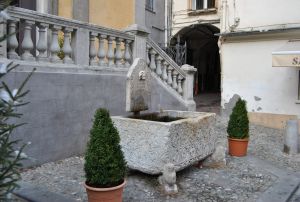
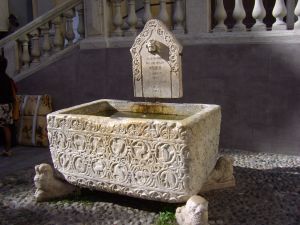 In the square between the Basilica and the Oratory there is a valuable white marble basin that some experts want to attribute to the early Middle Ages or late antiquity. It was one of the two drinking troughs for horses that the official Colonel Momber of Her Majesty's British Majesty had donated to the City at the beginning of the 20th century.
In the square between the Basilica and the Oratory there is a valuable white marble basin that some experts want to attribute to the early Middle Ages or late antiquity. It was one of the two drinking troughs for horses that the official Colonel Momber of Her Majesty's British Majesty had donated to the City at the beginning of the 20th century. 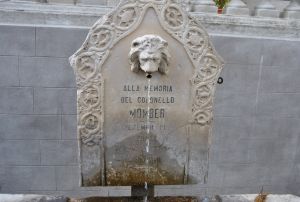
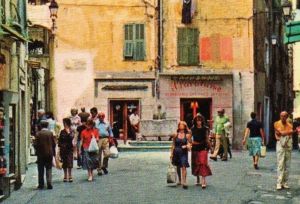 In ancient times they were placed at the mouth and at the entrance of via Nino Bixio. The FAI (Fondo Ambiente Italiano) promoted its restoration in 1992 and following the pedestrianisation of the district and the relative restoration of the road pavements was transferred from the small square in via Corradi to the present location.
In ancient times they were placed at the mouth and at the entrance of via Nino Bixio. The FAI (Fondo Ambiente Italiano) promoted its restoration in 1992 and following the pedestrianisation of the district and the relative restoration of the road pavements was transferred from the small square in via Corradi to the present location.
(sources: text by Ernesto Porri; images: personal and archival)




